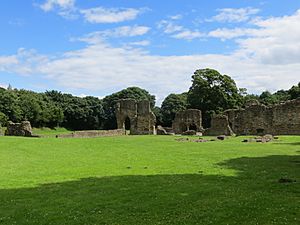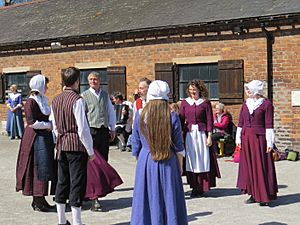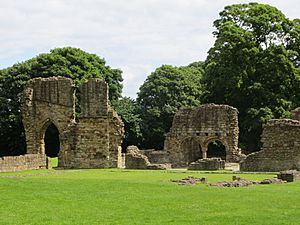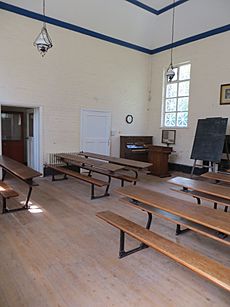Greenfield Valley Heritage Park facts for kids
Greenfield Valley Heritage Park is a large, 70-acre country park located in North Wales, in a place called Greenfield, near the town of Holywell. It's a special place known for its beautiful woodlands, calm reservoirs, and very old historical sites. These sites include the ruins of Basingwerk Abbey and many old factories. These factories played a big part in the Industrial Revolution, a time when new machines and factories changed how things were made.
Contents
Exploring the Old Factories
Many of the factories in Greenfield Valley were built in the late 1700s. They used the power of water from the Holywell Stream to run their machines. Most of these factories closed down by the 1960s. You can still see some of these old factory buildings today, which helps us imagine what life was like long ago.
The Battery Factory
The Battery Works was a factory where local people shaped pots and pans. They used sheets of brass, a type of metal. The term "battery brass" meant brass sheets that were shaped by hammering. This hammering was done using a large water wheel, which got its power from the nearby Battery Pond.
Close to the Battery Factory, you can see the ruins of Battery Row. This was a row of houses where many of the factory workers used to live. Today, the Battery Factory stands in ruins next to the pond. It is now supported by the National Welsh Heritage Lottery Fund, helping to preserve its history.
Meadow Mill
The Meadow Mill was built in 1787. This factory was important for making rolled copper sheets. These sheets were used by companies owned by a man named Thomas Williams.
The Lower Cotton Mill
In 1777, cotton manufacturing came to Greenfield Valley. John Smalley, a partner of the famous Richard Arkwright, built the first cotton mill here. It was called the Old or Yellow Cotton Mill. This spot was perfect because the stream rarely flooded or froze, and its water flowed at a steady speed. This helped make very good quality cotton thread. Smalley's mill was only the second cotton mill built specifically for that purpose in the whole country. The stone used to build it came from the nearby Basingwerk Abbey ruins.
After Smalley passed away in 1782, his wife Elizabeth teamed up with other business people. They built three more cotton mills in the valley: the Upper Mill, Lower Mill, and Crescent Mill.
The Lower Cotton Mill was built very quickly in the summer of 1785, taking only ten weeks! It was a very tall building, six stories high. It was powered by a large water-wheel. People at the time were amazed by this mill. A writer named Thomas Pennant called it a "most magnificent cotton works." He said it seemed to appear "as if by magic" and soared "like the tower of Babel" above other buildings. By 1787, the mills in Holywell were so productive that a newspaper, The Times, reported that "as much thread is spun in one day at Holywell... as will surround the globe at the equator."
The Lower Cotton Mill building is still standing today. However, visitors are not allowed to go inside. You can still see parts of the old machinery used in the factory outside the building.
Abbey Wire Mill
At the Abbey Wire Mill, workers made wire from copper and brass. Most of this factory has been destroyed over time. Only a few parts of the ruins can still be seen today.
Basingwerk Abbey
The park is home to the ancient ruins of Basingwerk Abbey. This was once a large and important monastery. Exploring the ruins can give you a glimpse into life hundreds of years ago.
The Old School
Near the visitor centre, you'll find an old village school. This school was originally built near Holywell town. It was then carefully taken apart and rebuilt in the valley. Today, visitors can experience what school life was like during Victorian times. Museum volunteers lead sessions that show how children learned and played back then.
Visitor Centre and Farm
The visitor centre is where your adventure into the park often begins. It's the entrance to a farm and a museum. The centre also gives you information about woodland walks, fun educational activities, and places for bird watching or fishing in the area.
Close to the Basingwerk Abbey ruins, there's a farm and museum that you can visit for a small fee. The farm has reconstructed local buildings, farm animals, and activities that are great for children. It's a fun way to learn about farming and rural life from the past.





